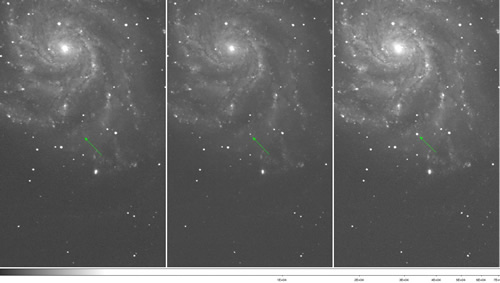UC San Diego’s HPWREN Aids in Recent Supernova Discovery
High-Performance Networks Speed Data on Explosion's Early Discovery
By:
- Jan Zverina
Published Date
By:
- Jan Zverina
Share This:
Article Content
A recent discovery by scientists at the Lawrence Berkeley National Laboratory (Berkeley Lab) and the University of California, Berkeley, of a supernova within hours of its explosion was made possible by a specialized telescope, state-of-the-art computational tools — and the high-speed data transmissions network of UC San Diego’s High-Performance Wireless and Research Education Network (HPWREN), as well as the Department of Energy’s Energy Sciences Network (ESnet).
The discovery late last month of the supernova is unique because it is closer to Earth — approximately 21 million light-years away — than any other of its kind in a generation of observations. Astronomers believe they caught the supernova just as it was about to explode, and researchers are now scrambling to observe it with as many telescopes as possible, including the Hubble Space Telescope.
The supernova, dubbed PTF 11kly, occurred in the Pinwheel Galaxy, located near the “Big Dipper,” in the Ursa Major constellation. It was discovered by the Palomar Transient Factory (PTF) survey, which is designed to observe and uncover astronomical events as they happen.
The PTF survey uses a robotic telescope mounted on the 48-inch Samuel Oschin Telescope at Palomar Observatory in Southern California to scan the sky nightly. As soon as the observations are taken, the data travels more than 400 miles to the National Energy Research Scientific Computing Center (NERSC), a Department of Energy supercomputing center at Berkeley Lab, via HPWREN and ESnet. Within hours of identifying PTF 11kly, this automated system sent the coordinates to telescopes around the world for follow-up observations.
“This discovery, and the process that followed, is a perfect example of the power of coordinated collaboration,” said Hans-Werner Braun, a research scientist with SDSC and HPWREN’s director. “It shows how effective scientific discovery can be when researchers combine their expertise to leverage technologies such as reliable telescopes, high-end spectrum analyzers, advanced supercomputing resources and high-speed data networks.”
Joshua Bloom, assistant professor of astronomy at the University of California, Berkeley, and author of the machine learning code that tipped off astronomers to the candidate, called it “the supernova of a generation.” Astronomers at Berkeley Lab and UC Berkeley, who made the discovery, predict that it will be a target for research for the next decade, making it one of the most-studied supernovae in history.
“We caught this supernova very soon after explosion. PTF 11kly is getting brighter by the minute,” said Peter Nugent, the senior scientist at Berkeley Lab who first spotted the supernova. Nugent is also an adjunct professor of astronomy at UC Berkeley. “Observing PTF 11kly unfold should be a wild ride. It is an instant cosmic classic.”

These images show Type Ia supernova PTF 11kly, the youngest ever detected. The left image taken on August 22 shows the event before it exploded, approximately 1 million times fainter than the human eye can detect. The center image taken on August 23 shows the supernova at about 10,000 times fainter than the human eye can detect. The right image taken on August 24 shows that the event is six times brighter than the previous day. Image credit: UC Berkeley
“We still do not know for sure what causes such explosions,” said Weidong Li, senior scientist at UC Berkeley and collaborator of Nugent. “We are using images from the Hubble Space Telescope, taken fortuitously years before an explosion to search for clues to the event's origin.”
The team will be watching carefully during the next few weeks, and the Hubble Space Telescope has studied the supernova's chemistry and physics. Catching supernovae so early allows a rare glimpse at the outer layers of the supernova, which contain hints about what kind of star exploded.
The scientists in the PTF have discovered more than 1,000 supernovae since it started operating in 2008, but they believe this could be their most significant discovery yet. The last time a supernova of this sort occurred so close was in 1986, but Nugent notes that this one was peculiar and heavily obscured by dust. “Before that, you'd have to go back to 1972, 1937, and 1572 to find more nearby Type Ia supernovae,” according to Nugent.
The project is supported by DOE's Scientific Discovery through Advanced Computing (SciDAC) program and by NASA.
The Palomar Transient Factory is a survey operated at Palomar Observatory by the California Institute of Technology on behalf of a worldwide consortium of partner institutions. Collaborators on PTF 11kly with Nugent, Bloom, and Li include Brad Cenko, Alex V. Filippenko, Geoffrey Marcy, Adam Miller (UC Berkeley), Rollin C. Thomas (Lawrence Berkeley National Laboratory), Sullivan (Oxford University), and Andrew Howell (UC Santa Barbara/Las Cumbres Global Telescope Network).
HPWREN is a collaborative Internet-connected cyberinfrastructure on research, education, and public safety activities. The project supports a wireless data network in San Diego, Riverside, and Imperial counties. The network includes backbone nodes, typically on mountain tops, to connect often hard-to-reach areas in remote environments. As one of the Applied Network Research (ANR) projects at the UC San Diego, HPWREN operates as a joint activity between SDSC and the California Institute for Telecommunications and Information Technology (Calit2).
Share This:
You May Also Like
UC San Diego is Strengthening U.S. Semiconductor Innovation and Workforce Development
Technology & EngineeringStay in the Know
Keep up with all the latest from UC San Diego. Subscribe to the newsletter today.



